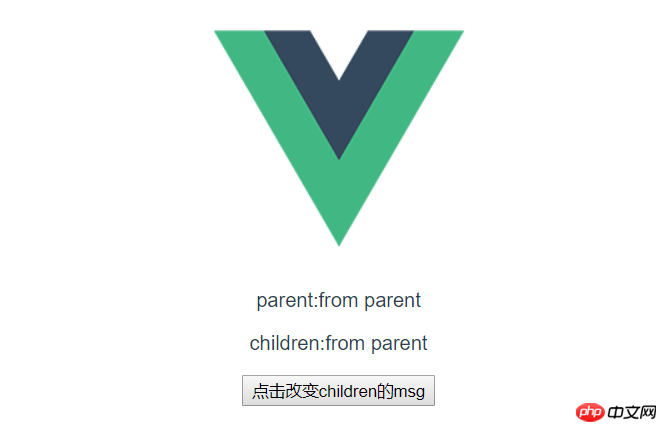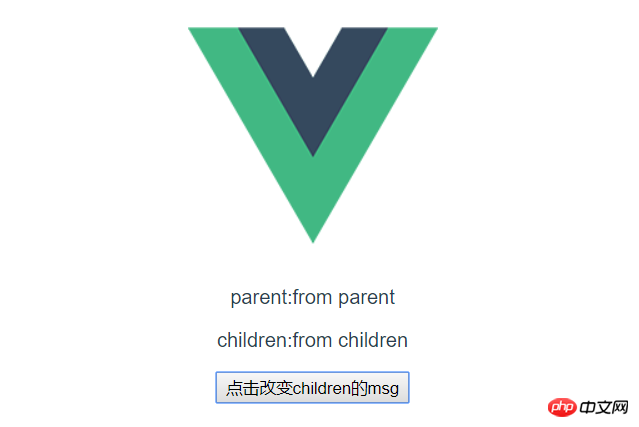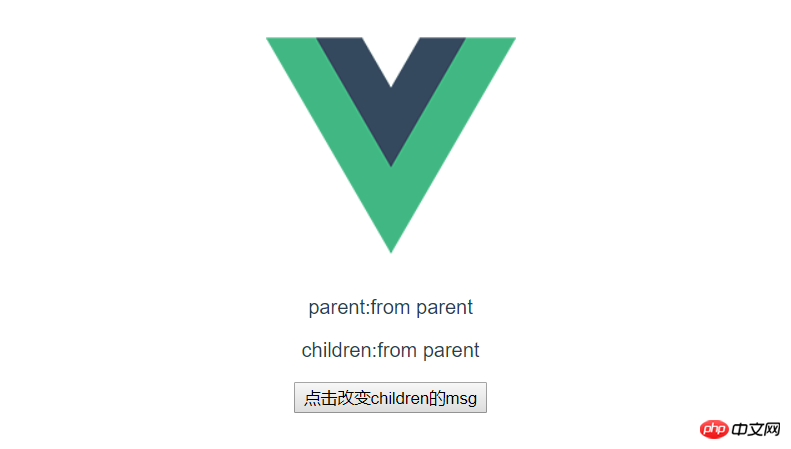Detailed explanation of vue data binding method
As we all know, vue is a one-way data flow, and child components cannot directly change variables in the parent component, as follows:
parent.vue
<template>
<p>
<p>parent:{{ msg }}</p>
<children :msg="msg"></children>
</p>
</template>
<script>
import children from '@/components/children'
export default {
name: 'parent',
data() {
return {
msg: 'from parent'
}
},
components: {
children
}
}
</script>children.vue
<template>
<p>
<p>children:{{ msg }}</p>
<p>
<button @click='changeChild'>点击改变children的msg</button>
</p>
</p>
</template>
<script>
export default {
name: 'children',
data () {
return {
}
},
props: ['msg'],
methods: {
changeChild() {
this.msg = 'from children'
}
}
}
</script>The page is as follows:

Click After:

The above is the most basic parent to pass data to the child component. Modifying variables of the child component does not affect the parent component. So what if the parent and child components want to be synchronized? At this time, you should use the this.$emit() function.
First type: v-model transfer
Parent component modification:
<template>
<p>
<p>parent:{{ msg }}</p>
<children v-model="msg"></children>
</p>
</template>Subcomponent modification:
<script>
export default {
name: 'children',
data () {
return {
}
},
model: {
prop: "msg"
},
props: ['msg'],
methods: {
changeChild() {
this.$emit('input', "child")
}
}
}
</script>Note: The model part cannot be omitted, the event triggered by this.$emit() is input (when the return event is not explicitly bound on the parent component, input is the default ), the value passed is child
page as follows:

After clicking:

It can be seen that the values of the parent and child components are synchronized
Second type: Explicitly specify the response event (@)
Parent component modification:
<template>
<p>
<p>parent:{{ msg }}</p>
<children @upChange="changeMsg" :msg="msg"></children>
</p>
</template>
<script>
import children from '@/components/children'
export default {
name: 'parent',
data() {
return {
msg: 'from parent'
}
},
components: {
children
},
methods: {
changeMsg() {
this.msg = "收到子组件信号,嘤嘤嘤"
}
}
}
</script>Child component modification:
<script>
export default {
name: 'children',
data () {
return {
}
},
model: {
prop: "msg"
},
props: ['msg'],
methods: {
changeChild() {
this.$emit('upChange', "给你一个value")
this.msg = 'from children'
}
}
}
</script>Here I deliberately modified the value of msg after emit. It turns out that this is not possible, so I guess that emit is an asynchronous function that will be executed at the end of the queue, which means that the value is assigned here' from children' was eventually overwritten.
It is worth mentioning that the second parameter of this.$emit() can pass the value to the parent component. It is very useful here. You can experience it by yourself
The page is as follows:

##After clicking:


After talking about the communication between father and son, it is natural to communicate between the child and child components. Yes, in fact, you are smart and should have figured out how to do it. That's right, it uses the parent component as a springboard to allow child components to achieve communication effects.
Here is a small example:
Parent component:
<template>
<p>
<children @upChange="changeMsg" :msg="msg"></children>
<children2 :msg2="msg2"></children2>
</p>
</template>
<script>
import children from '@/components/children'
import children2 from '@/components/children2'
export default {
name: 'parent',
data() {
return {
msg: 'from parent',
msg2: 'from parent'
}
},
components: {
children,
children2
},
methods: {
changeMsg(value) {
this.msg = value
this.changeChild2()
},
changeChild2() {
this.msg2 = "children2收到 children2收到 over over!"
}
}
}
</script>Sub-component one:
<template>
<p>
<p>children:{{ msg }}</p>
<p>
<button @click='changeChild'>点击呼叫children2</button>
</p>
</p>
</template>
<script>
export default {
name: 'children',
data () {
return {
}
},
model: {
prop: "msg"
},
props: ['msg'],
methods: {
changeChild() {
this.$emit('upChange', "children2,children2,收到请回答,收到请回答")
}
}
}
</script>Sub-component two:
<template>
<p>
<p>children2: {{ msg2 }}</p>
</p>
</template>
<script>
export default {
name: 'children2',
data () {
return {
}
},
props: ['msg2']
}
</script>The page is as follows: After clicking:


Two tree array constructors without recursion
Convert HTML to Excel, and realize printing and downloading functions
The above is the detailed content of Detailed explanation of vue data binding method. For more information, please follow other related articles on the PHP Chinese website!

Hot AI Tools

Undresser.AI Undress
AI-powered app for creating realistic nude photos

AI Clothes Remover
Online AI tool for removing clothes from photos.

Undress AI Tool
Undress images for free

Clothoff.io
AI clothes remover

Video Face Swap
Swap faces in any video effortlessly with our completely free AI face swap tool!

Hot Article

Hot Tools

Notepad++7.3.1
Easy-to-use and free code editor

SublimeText3 Chinese version
Chinese version, very easy to use

Zend Studio 13.0.1
Powerful PHP integrated development environment

Dreamweaver CS6
Visual web development tools

SublimeText3 Mac version
God-level code editing software (SublimeText3)

Hot Topics
 How to use bootstrap in vue
Apr 07, 2025 pm 11:33 PM
How to use bootstrap in vue
Apr 07, 2025 pm 11:33 PM
Using Bootstrap in Vue.js is divided into five steps: Install Bootstrap. Import Bootstrap in main.js. Use the Bootstrap component directly in the template. Optional: Custom style. Optional: Use plug-ins.
 How to add functions to buttons for vue
Apr 08, 2025 am 08:51 AM
How to add functions to buttons for vue
Apr 08, 2025 am 08:51 AM
You can add a function to the Vue button by binding the button in the HTML template to a method. Define the method and write function logic in the Vue instance.
 How to use watch in vue
Apr 07, 2025 pm 11:36 PM
How to use watch in vue
Apr 07, 2025 pm 11:36 PM
The watch option in Vue.js allows developers to listen for changes in specific data. When the data changes, watch triggers a callback function to perform update views or other tasks. Its configuration options include immediate, which specifies whether to execute a callback immediately, and deep, which specifies whether to recursively listen to changes to objects or arrays.
 What does vue multi-page development mean?
Apr 07, 2025 pm 11:57 PM
What does vue multi-page development mean?
Apr 07, 2025 pm 11:57 PM
Vue multi-page development is a way to build applications using the Vue.js framework, where the application is divided into separate pages: Code Maintenance: Splitting the application into multiple pages can make the code easier to manage and maintain. Modularity: Each page can be used as a separate module for easy reuse and replacement. Simple routing: Navigation between pages can be managed through simple routing configuration. SEO Optimization: Each page has its own URL, which helps SEO.
 How to reference js file with vue.js
Apr 07, 2025 pm 11:27 PM
How to reference js file with vue.js
Apr 07, 2025 pm 11:27 PM
There are three ways to refer to JS files in Vue.js: directly specify the path using the <script> tag;; dynamic import using the mounted() lifecycle hook; and importing through the Vuex state management library.
 How to return to previous page by vue
Apr 07, 2025 pm 11:30 PM
How to return to previous page by vue
Apr 07, 2025 pm 11:30 PM
Vue.js has four methods to return to the previous page: $router.go(-1)$router.back() uses <router-link to="/" component window.history.back(), and the method selection depends on the scene.
 How to use vue traversal
Apr 07, 2025 pm 11:48 PM
How to use vue traversal
Apr 07, 2025 pm 11:48 PM
There are three common methods for Vue.js to traverse arrays and objects: the v-for directive is used to traverse each element and render templates; the v-bind directive can be used with v-for to dynamically set attribute values for each element; and the .map method can convert array elements into new arrays.
 How to jump to the div of vue
Apr 08, 2025 am 09:18 AM
How to jump to the div of vue
Apr 08, 2025 am 09:18 AM
There are two ways to jump div elements in Vue: use Vue Router and add router-link component. Add the @click event listener and call this.$router.push() method to jump.






